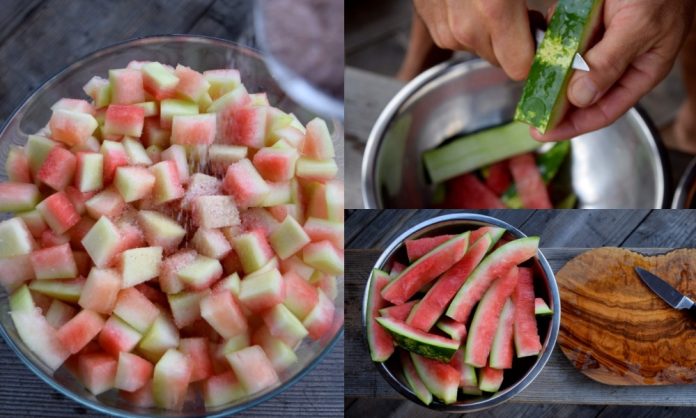Watermelon Rind
As summer winds down, don’t let those leftover watermelon rind go to waste! Transform them into a zesty, addicting snack or condiment by pickling the nutrient-rich green rind. Read on to learn the surprisingly simple process of watermelon rind pickling along with serving ideas. It makes a fun weekend project!
An Introduction to Pickled Watermelon Rinds
Before we begin, let’s look at what exactly pickled watermelon rinds entail:
Using the Rind Instead of Fruit
The green exterior rind is the tough skin covering a watermelon’s pink or red moist interior fruit. While we discard the rind after enjoying the sweet watermelon flesh, it can be preserved through pickling instead.
Pickling the Rind
The watermelon rind is pickled by cutting into cubes or spears, boiling briefly, then storing submerged in a brine of vinegar, sugar, and spices for 1-2 weeks until tangy and infused with flavor.
Serving Options Once Pickled
The finished pickled watermelon rinds make a delicious snack or add a striking flavor contrast and crunch to salads, pork dishes, charcuterie and cheese boards, and bloody mary cocktails too!
Benefits and Uses of Pickled Watermelon Rinds
Transforming watermelon rinds into tangy pickle cubes offers many advantages:
Reduces Food Waste
Rather than composting watermelon rinds, pickling captures their remaining nutrients and eliminates waste from discarded fruit skins.
Adds Fiber and Nutrients
Surprisingly, watermelon rinds contain more nutrients like vitamins, minerals, and antioxidants than the juicy red flesh we typically enjoy!
Provides Crisp Texture Contrast
The pickled rinds offer great textural contrast when served alongside smooth avocado toast, creamy salads, rich pork belly, and more.
Infuses Drinks
Muddle or skewer pickled watermelon rinds for a tangy addition to refreshing summer cocktails and mocktails.
Extends Seasonal Availability
Preserved properly, pickled watermelon rinds can be enjoyed for up to 12 months, allowing their summery essence to shine all year round!
Step-By-Step Instructions for Pickling
Without further ado, here is the easy methodology for transforming watermelon rinds into delicious pickles:
Prep the Rinds
Slice off the outer green and white layers of rind from discarded watermelon flesh. Cut into 1-inch cubes
or 1⁄2-inch thick by 3-inch long spears.
Boil Briefly
Boil rind pieces for 7-10 minutes to reduce bitterness, then drain and rinse until cool enough to handle.
Make the Brine
Heat vinegar, sugar, and spices like cinnamon sticks, whole cloves, peppercorns, coriander seeds, and chiles in a nonreactive saucepan until sugar dissolves.
Transfer to Jars
Tightly pack blanched rinds into sterilized jars. Pour hot brine over rinds, allowing 1⁄2 inch headspace
before sealing the jars.
Ferment
Store sealed jars at room temperature away from sunlight for 1-2 weeks to ferment, creating delicious pickled rinds!
Serving Suggestions for Pickled Watermelon Rinds
Once pickled, enjoy your homemade creation in creative ways:
Straight from the Jar!
Eat pickled watermelon rinds straight from the jar as a healthy low-carb snack. The tanginess stimulates the senses!
On Charcuterie Boards
Arrange colorful pickled watermelon rind spears on cheese and charcuterie platters for visual appeal and tart contrast beside fatty meats.
In Summer Salads
Chop rinds and add to fresh spinach salads with Healthiest berries, goat cheese, and nuts or grain-based salads for crispy bites.
On Pork Sandwiches
Pile tangy pickled watermelon rinds on top of juicy pulled pork sandwiches for a sweet and sour crunch.
In Cocktails
Muddle or skewer pickled rind cubes as garnish for mint juleps, peach sangria, and summer spritzers.
Conclusion
Rather than tossing watermelon rinds, transform these nutrient powerhouses into delicious pickled condiments or snacks. Creatively worked into cocktails, platters, salads, and sandwiches, homemade pickled watermelon rind makes kitchen waste wonderfully tasty!
FAQs About Pickling Watermelon Rinds
Can you eat the white rind on a watermelon along with the red flesh?
While the white rind is edible, it doesn’t taste nearly as sweet or enjoyable as the vibrant interior red flesh we typically eat. Save the rind for pickling instead.
Do you have to peel watermelon rinds before pickling them?
Simply slice off the very outer green skin, leaving the white pithy rind intact to pickle. No need to peel –
just cube the white rind once the green exterior is removed.
How long will pickled watermelon rinds keep stored properly?
Pickled watermelon rinds will maintain best quality for 12 months sealed in sterilized jars stored in a cool, dark place like the refrigerator or pantry away from light.
What vinegar works best for pickling watermelon rind?
A neutral white vinegar like distilled white or champagne vinegar provides a crisp flavor base. Apple cider and rice wine vinegars also work well based on personal taste preferences for sweeter or more acidic pickled versions.
Can you customize pickled watermelon rinds with different seasonings?
Absolutely! Tailor your brine to preferred tastes by experimenting with spices like ginger, allspice, bay leaves, mustard seeds, jalapeños, crushed red pepper, tarragon, dill and more.








